Ice Fishing Shelter Floor Ideas (5 Top Options To Use)
UPDATED 18 MAY 2023
by Robert Ceran
By definition, ice fishing means going outside of your comfort zone, and spending long hours fishing through the ice is definitely not the most comfortable thing to do
But avid ice anglers have figured out creative solutions to make their time on the ice as comfortable as possible.
One of these solutions is to add flooring to your ice fishing shelter. With a little bit of know-how you can outfit your shelter with a floor that will keep you both warm and dry while ice fishing.
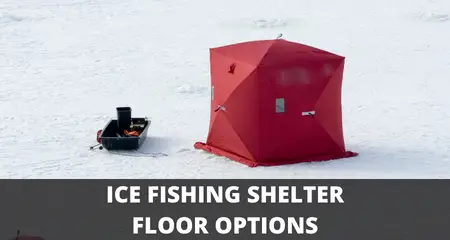
In this article we’ll show you the 5 top floor materials for ice fishing shelters, and will walk you through the pros and cons of each, to help you choose the right one for your purposes.
What can you use for an ice fishing shelter floor?
The 5 best options to use for an ice shelter floor are:
- Interlocking EVA foam tiles
- Composite deck tiles
- Interlocking rubber mats
- Yoga mats
- Kneeling pad for gardening
It should be noted that some shelter manufacturers (such as Clam) also offer floor options that are built to fit in their shelters.
However, in our experience this is not the best option to use for your floor, since these generally can’t be customized to fit different needs, which means you can only use them with exactly the shelter they were intended for.
The materials listed above are better floor options because they are cheap, readily available, and can be easily adapted to fit the shape of your shelter, no matter what brand.
So no matter what kind of ice fishing shelter you have, you can quickly and easily make a floor that fits your shelter, as well as being lightweight and portable.
Now let’s dive into the details and take a closer look at each of these ideas for ice shack floors.
Interlocking EVA foam tiles (best overall option)
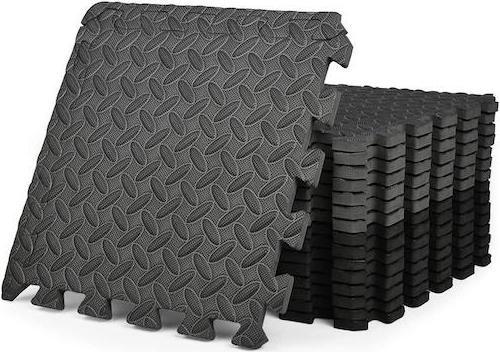
In my experience these interlocking foam mats made of EVA are by far the best option to use for flooring inside an ice shelter.
EVA is a high density form of plastic, and it is not only extremely lightweight and durable, but also functions as an excellent heat insulating barrier between your feet and the ice.
In addition, it has a non-slip surface and muffles noise, which helps to avoid scaring fish underneath the ice.
And my favorite feature are the interlocking edges of these square foam tiles, which makes it very easy to put them together in various configurations, and thereby customize the floor shape and size to match your shelter.
Composite deck tiles
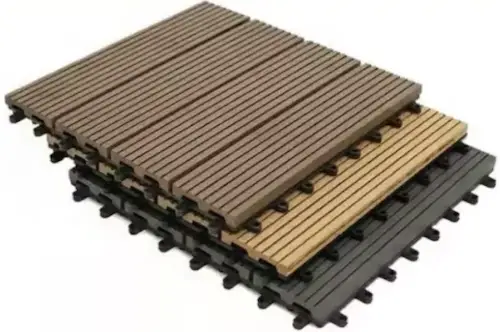
Composite plastic tiles are harder than EVA, and are most often used to tile patios and other outdoor areas.
These tiles are much more solid than EVA or rubber tiles, which some ice anglers prefer. They also offer effective insulation from the cold, and keep your feet dry.
They fit together with a similar design to interlocking foam tiles, which makes them easy to deploy in your shelter.
Interlocking rubber mats
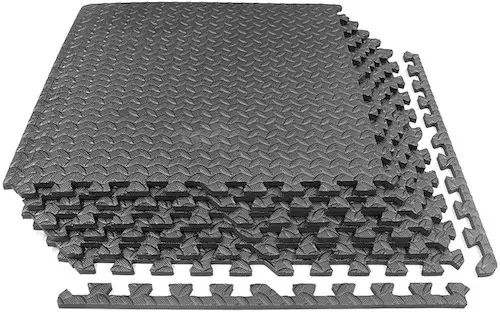
These mats are often used as rubber floor tiles in gyms, and are easy to snap together.
They are similar to EVA tiles in many regards, but are harder and thus less flexible. Some anglers prefer their rigidity, which feels more solid when you stand on them.
Rubber mats are also slightly heavier and less insulating than EVA foam tiles, but otherwise broadly interchangeable.
Finally, some types of tiles combine both EVA and rubber in multiple layers, and these usually come with the highest degree of insulation.
Yoga mats
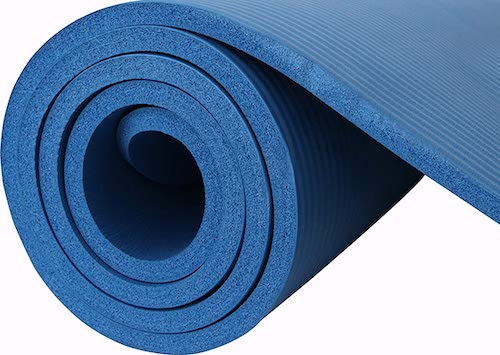
Few ice anglers know yoga mats can make a great floor in your ice fishing pop up. But be aware that not all yoga mats are created equal.
For ice fishing you should avoid the thin variety and instead need to make sure you get one that’s at least half an inch thick and made of high density foam.
You can cut these into smaller pieces to fit your space, which makes them easy and quick to deploy.
Their main disadvantage is that they don’t interlock at the edges, which makes them less resistant to snow and slush.
Kneeling pad for gardening
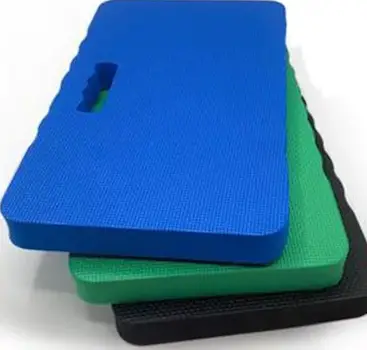
These pads are not only great for gardening, but their portability and thickness also makes them perfect for ice fishing.
With a thickness of up to 1 1/2 inch, they are considerably thicker than all other floor options, and provide the highest level of comfort for kneeling on the ice.
What makes a good ice shelter floor?
When choosing the best material to use for your flooring, here are the key properties to look for:
- Heat insulating
- Waterproof
- Durable
- Sufficiently thick
- Lightweight
- Easy to set up
- Cheap
Let’s examine each of these more closely.
Since the main advantage of having a floor in your ice shanty is that it protects you from the cold, you’ll want to choose material that has the maximal amount of insulating effect.
I’ve found that EVA foam insulates better than most other materials, closely followed by rubber.
However you may find that other materials are good enough for your purposes, as long as they perform well in most other regards.
In addition to being heat insulating, you also need your flooring to be waterproof or at very least water-resistant. And by the way, this is why you absolutely shouldn’t use carpet for this purpose.
This non-absorbent property is essential in order to make sure your tiles won’t absorb water from slushy ice, since you need it to keep you dry.
Durability is an important property, since your flooring will be subjected to a lot of punishment out on the ice, and you want it to last for more than one ice fishing season.
Thickness is another important factor, since that will help both with the insulation and keeping you dry. In general, the best type of flooring option should be at least half an inch thick.
Lightness of weight is important for all your ice fishing equipment, since you need to transport it around on the ice (unless you use an ATV or snowmobile to transport your ice fishing gear).
So choose a floor material that’s as lightweight as possible, as that allows you to carry more rods, reels, and other fishing tackle.
You also want your flooring material to be easy to deploy when you need it, which is why my favorite choices are interlocking EVA or rubber tiles, since setting them up is child’s play.
Finally, you should also look for an option that is cheap, since that will help to keep your overall expenses for ice fishing lower.
Fortunately, most of the options discussed above are very budget friendly, and you should be able to cover your flooring needs for less than $30.
Why should you have a floor inside an ice fishing shelter?
The main benefit of having a floor in your ice shelter is that it helps to insulate you from the cold.
With that being said, you don’t absolutely need a floor in an ice fishing shelter, but it’s extremely nice to have one if you’re going to spend a lot of time in your pop up in freezing cold temperatures (for example if you’re planning to ice fish at night).
It goes without saying that the surface of the ice is very cold, and if you spend many hours on the ice while waiting for fish to bite, you’ll eventually start to feel the cold creep into your limbs.
If that happens, it can take all the fun out of ice fishing, which is why it’s a good idea to do whatever you can to insulate yourself from the cold.
Also, in addition to insulating you from the cold, a floor in your hub house helps to protect your knees when you need to kneel down on the ice.
Some people kneel on the ice while they’re ice fishing, while others only kneel on the ice when they need to land a sizable fish through the ice.
In either case, the hard surface of the ice makes kneeling on it very uncomfortable, and so having the soft cushioned surface of rubber or EVA flooring makes this much more pleasant.
Finally, having a floor in your ice fishing shelter also helps to keep you dry, as it allows you to avoid contact with the slushy surface of the ice. This is a huge help when it comes to feeling comfortable ice fishing for long periods of time.
If you’ve ever been soaked wet by slushy ice, and then felt the freezing cold twice as much afterwards, you know exactly what I’m talking about.
And if you’re using a portable heater inside the shelter, the surface of the ice is eventually going to melt and get slushy, and it’s better to protect yourself from getting soaked by it.
Do you need a wall to wall floor in your ice shelter?
No, in fact it’s better to put flooring only in those areas of your shelter where you will be sitting or kneeling, or where you want to store all the ice fishing equipment you need to keep dry.
Doing it this way means the rest of the ice surface inside your shelter is available for drilling ice holes and for fishing through them.
You can also use the exposed ice to keep any fish that you catch fresh before you pack up and take them home.
As a rule of thumb, I like to have enough flooring material to cover about half of the surface ice inside my pop up shelter.
When not to use flooring in an ice shelter
While putting a floor in your ice fishing tent is very helpful in most cases, there are a couple of scenarios where it’s better to avoid it.
In general, it’s not a good idea to use flooring in your flip over shelter if the ice is covered by thick snow (or slushy snow).
Under conditions like that it’s hard to get the tiles to lock together properly and form a contiguous surface, and instead you’ll end up with a lot of snow and sludge on top of the tiles, which defeats the purpose of having a floor in the first place.
Another reason not to use a floor is if you’re only planning to ice fish for a relatively short period of time, and plan to pack up your shelter shortly.
This is most often the case when you want to do hole hopping or ice trolling, where mobility becomes the most important factor to focus on.
Do ice fishing shelters come with floors?
Most ice fishing shelters are sold without floors, even if the manufacturer makes a suitable flooring option. That means you need to purchase the floor separately if you want to make sure you have it on your next ice fishing trip.
Can you buy a floor designed for your ice shelter?
Only a few manufacturers of ice fishing shelters provide floors. One of these is Clam, which has several flooring options that are specifically designed to fit some of their shelters.
A great example is their X-series Thermal Floor, which fits inside a Clam Hub Shelter.
The advantage of this floor is that it uses velcro to attach to the sides of the shelter, and also comes with several velcro openings that allow you to access the ice to drill your holes and fish through them.
If you need extra space for transporting all your ice fishing equipment, check out our article on the biggest ice fishing sleds.
Final remarks
While an ice fishing shelter shields you from the wind, the fact that you are standing on ice still causes the cold to get in through your boots, and as a result your feet and lower extremities are bound to get chilly.
Even with the most comfortable ice fishing seat, insulated clothes, best boots, and sophisticated shelters, you will eventually become cold on the ice.
But by installing effective flooring in your shelter, you can significantly reduce the chill factor on the ice. And even if you don’t fish inside a shelter, flooring can improve your comfort significantly.
With a little bit of effort, you can put together the ideal ice fishing shelter setup for yourself in no time at all, and in my experience this will help make your ice fishing experience much more enjoyable.
